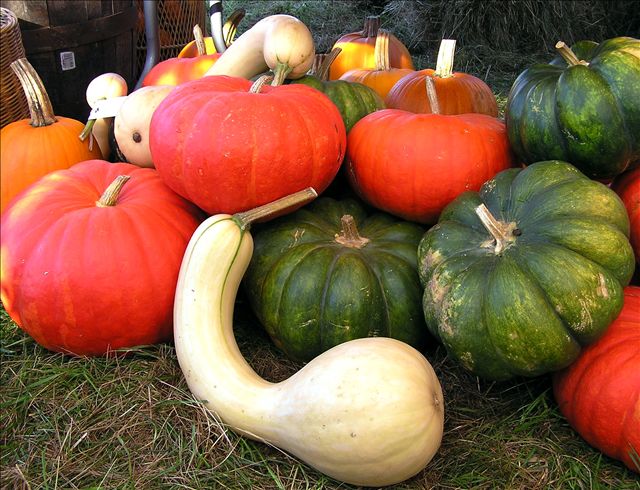 |
May 2009
By Jean English and Eric Sideman
Photo by Jean English
A 50-foot row of winter squash can yield 80 pounds or more – 80 pounds of a high-fiber vegetable that is rich in vitamins and minerals, can be stored long into winter and makes a delicious main course, side dish or dessert. Yes, winter squash takes a fair amount of room to grow, but its bounty is an excellent way to help feed yourself quality food for much of the year.
A good soil for growing winter squash will be well-drained, fertile and high in organic matter. A technical bulletin called “Basics of Organic Vegetable Gardening” (available from the Maine Organic Farmers and Gardeners Association at www.mofga.org under “Publications”) recommends digging a hole 10 to 12 inches deep for each “hill” of winter squash plants. A hill is not a mound, but simply a group of three to five plants. Put 1/2 to 1 cup of rock phosphate (if a soil test shows that your garden needs phosphorus) and 4 or 5 cups of well-rotted manure in the bottom of the hole. Mix 1 cup of wood ashes with the soil that you dug from the hole and fill the hole with that soil. Make additional hills 3 to 5 feet apart.
After the last spring frost (usually in mid-May to early June, depending on your location in Maine), sow three to five seeds in each hill. Some gardeners start squash plants indoors a few weeks before the last spring frost and transplant them to the garden after the last frost—being careful not to disturb their roots. And some put black plastic mulch down a couple of weeks before planting and plant seeds or transplants through that after the last spring frost.
Once the plants or seeds are in the ground, keep the soil moist: Mulch with newspapers covered with grass clippings if you did not use plastic mulch; or water the plants when the soil starts to become dry.
To keep cucumber beetles from attacking these plants (and spreading bacterial wilt disease, which can kill the plants), cover them with fabric row covers – but remove the covers once the plants flower so that bees can get at the flowers to pollinate them.
Harvest winter squash after its skin is mature enough to resist being punctured by your fingernail. Store the vegetables at room temperature in a dry place. Check them every week or so. Any that seem to be softening or showing imminent signs of rotting should be cooked right away. You can freeze cooked squash flesh for later use.
Winter squash will be the featured “crop of the year” at MOFGA’s Common Ground Country Fair exhibition hall on September 25, 26 and 27 this year. The Exhibition Hall coordinators hope that gardeners and farmers will enter enough variety to create a spectacular display of not just the common ‘Buttercups,’ ‘Hubbards’ and ‘Waltham Butternuts’ but also heirloom varieties from around the world—such as ‘Japanese Futsu,’ ‘French Galeux d’Eysines,’ ‘Australian Queensland Blue,’ ‘Yugoslavian Finger Fruit,’ ‘Pennsylvania Dutch Crookneck’ or ‘Italian Marina di Chioggia’.
This article is provided by the Maine Organic Farmers and Gardeners Association (MOFGA), PO Box 170, Unity, ME 04988; 207-568-4142; [email protected]; www.mofga.org.
Joining MOFGA helps support and promote organic farming and gardening in Maine and helps Maine consumers enjoy more healthful, Maine-grown food.
Copyright 2009. If you reprint this article, please include this reference, and please let us know that you have reprinted. Thanks!
